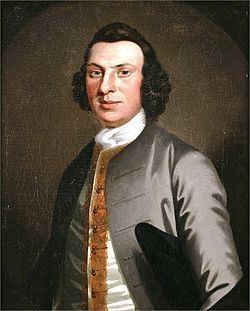Name Frederick III | ||
 | ||
Frederick Philipse III (1720-1786) was an American landowner who was the third and last Lord of Philipsburg Manor and a Loyalist during the Revolutionary War.
Contents

Early life
Frederick Philipse III was the son of Frederick Philipse II (1698-1751), 2nd Lord of Philipsburg Manor, and Johanna Brockholst. When his father died in 1751, he inherited Philipsburg Manor, a 52,000 acre estate comprising much of southern Westchester County, the accompanying title, and commercial interests, including the share of family holdings his father had received from Adolphus Philipse, a bachelor uncle and son of Frederick I, the first Lord of Philipsborough. He did not receive his uncle's 250 square mile Highland Patent, a tract later known as the Philipse Patent, which became today's Putnam County, New York. It was divided among three of his siblings.
Career
Philipse was a member of the Assembly of the colonial Province of New York, and a Colonel in the militia.
American Revolution
Like the rest of his family, Philipse was a Loyalist during the American Revolution. At the onset he leased his lands and left for England, never to return. All lands and commercial interests were lost during the American Revolution when Philipse was attained in absentia, seized by the then-still Colony of New York, then auctioned off by the Commissioners of Forfeiture. As such, he was attained by the Provincial Congress of New York in 1779 and his Manor and other lands in today's Westchester County were seized. Several months later their sale was ordered.
Philipse family holdings belonging to other members, principally the Highland Patent, were also seized by the Commissioners of Forfeitures. Sale was withheld during the war, as its outcome was uncertain, confiscated lands had been pledged as collateral against monies borrowed by the provisional government to finance the conflict, and tenants lobbied for the right of preemptive purchase of leased land.
Sale proceeded after the Revolution ended. In spite of assurances of restitution in the 1783 Treaty of Paris signed with the British, and the enormous sum raised – the better part of a quarter of a million pounds Sterling – New York's Provisional Congress reneged and no compensation was forthcoming.
Several thousand acres of the Philipse estate went to the tenant farmers who worked on the land. In all, the lands were divided up into almost 200 different parcels, with the bulk of the holdings going to Dutch New York businessman Henry Beekman.
Personal life
Frederick Philipse married Elizabeth Williams, widow of one Rutgers, and they had:
On April 30, 1786, at the age of sixty-five, Frederick Philipse III died in St. Oswald’s Parish, Chester, England, three years after the Treaty of Paris in 1783. After losing his New York holdings due to his loyalist stance during the American Revolution, Frederick III and his family relocated to the area, where he spent the remainder of his life. On May 2, 1786, he was buried in Chester Cathedral (most likely in the South transept, which was the parish church during that period). In 1787, a British court decided that the inheritance rights of heirs to property that was confiscated by the Americans during the American Revolution was recoverable.
Family
Founding Father John Jay, coauthor of the Treaty of Paris, co-author of the Federalist Papers, the first Chief Justice of the Supreme Court, and the second American Governor of New York was a cousin, on his maternal side.
